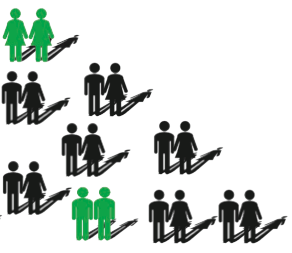Are Gays Really Just 1.6% of the U.S. Population?
The Centers for Disease Control and Prevention, the federal government’s watchdog for health statistics has just released a 2013 National Health Survey on its gay citizens, which it compiled by having the Census Bureau interview 33,557 adults between the ages of 18 and 64. The actual report can be found at http://www.cdc.gov/nchs/data/nhsr/nhsr077.pdf. The government began by asking respondents their sexual orientation. Only 1.6% of those willing to be interviewed self-identified as gay, with another .7% announcing that they were bisexual. This is the lowest estimate of the number of gays in the country produced in modern times and it’s caused quite a stir. Homophobes were thrilled, with one blogger exclaiming, “
The CDC is doing a service, because it has clearly de-bunked the ‘10% of the population’ claim that the gay-rights movement has routinely pushed,” and another stating that even this new number is too high: “This comes from the Obama machine, trying to normalize their perversions. . . . The real number is less than 1/10th of 1%.” (Some people are never satisfied.) Many rightwing commentators bloviated that if there are that few gays in the country they're seriously over-affecting the national scene, and have way too much political clout. One asked, “Does every TV show have to have a gay character if there are so few of them around?” The American Family Association, proud as always of its homophobia, promptly noted that gays are a
“tiny little minority” and added, “It's almost comical that
we have allowed these people to have so much power in our culture where they
can force their deviant lifestyle into the public sphere and compel so many
sectors of society to recognize this and to celebrate it as some kind of normal
lifestyle.” [See http://www.huffingtonpost.com/2014/07/16/bryan-fischer-gay-population-_n_5592036.html]
I’ve
explained before on this blog why the true number of gays and lesbians in the
country is at least ten percent [click on these links: “How Many Homosexuals
Are There in the World,” November 8, 2010 at http://douglaswhaley.blogspot.com/2010/11/how-many-homosexuals-are-there-in-world.html
and “Homosexuality: The Iceberg Theory,” April 25, 2010 at http://douglaswhaley.blogspot.com/2010/04/homosexuality-iceberg-theory.html]. Must I now retreat from that claim, nibbling
humble pie?
Nope. Ten percent or higher is still my number and
this blog post explains why.
Getting
accurate statistics about homosexual desire is an almost impossible task. The
reasons are obvious: in most countries homosexuality is so buried that people
will not answer questions truthfully about it, or, even if they do, they may
not know the truth. I lied to myself until age 32 about whether I was a
homosexual, and during that period I would certainly have answered “no” to a
questionnaire on point, even though in reality I was always a homosexual. In a
1993 study questionnaires were mailed to thousands of American men asking about
their sexual orientation. There was a large no-response rate, and those
responding proudly declared they were very heterosexual. As a follow-up to the
no-response questionnaires, the study leaders sent women with clipboards
to ring doorbells and ask men the questions orally. Of the men willing to talk
to the women, almost none said they were gay. So the study’s ultimate
conclusion was that homosexuals made up only 1% of the population of the United
States. This ridiculous nonsense was much derided by experts in statistical
analysis and by gay people themselves. At
the 1993 "March on Washington for Lesbian, Gay, and Bi Equal Rights and
Liberation" this was a popular button worn by marchers:
This
new survey suffers from similar problems. People and households were
contacted and asked if they were willing to participate in the study, which was
done face-to-face, with follow-up telephone interviews. I believe that huge numbers of them lied
about their sexual orientation, and here is a list of the reasons why:
1. Married
People. Almost all of the married
male/female couples said they were both straight. Well . . . duh . . . of course they would!
If you’re gay and in a marriage with a person of the opposite sex you
don’t suddenly come out to him/her when a government worker with a computer
comes a-calling. You lie and avow complete heterosexuality. But back in the days when I went on gay
dating websites looking for love/lust, about half of the men who contacted me
were married (at which point I refused to get involved). I was once married to a woman myself and didn’t
admit to her that I was a homosexual until I decided that even though it would
break up our marriage it was the honorable thing to do [see “The Aging Gay
Activist,” March 24, 2012 at http://douglaswhaley.blogspot.com/2010/03/aging-gay-rights-activist.html,
“I Married a Hippy,” April 14, 2010 at http://douglaswhaley.blogspot.com/2010/04/i-married-hippy.html],
and “Marijuana and Me,” July 11, 2010 at http://douglaswhaley.blogspot.com/2010/07/marijuana-and-me.html].
2. Kids
Under 18. For the children in the
home under 18 the parents revealed
their sexual orientation and—wouldn’t you just know it?—there were almost no gay children. But a fairly recent study of high school
students in the Washington
area had it that 15.3% of respondents
identified as gay, lesbian or bisexual.
Hmm. 15.3%? What will that number
be when they get older? At the magic age
of 18 will they suddenly become so heterosexual that it will shrink to 2.3%?
3. It’s
the Federal Government at the Door! In 2014 when everyone is suspicious of the
government for overzealous information gathering and invasion of privacy, how
many gay people want a federal record of their sexual orientation to go into
the national data base? You’d have to be
very, very comfortable with both your sexual orientation and your place in the
world before you answered truthfully.
4. Self-Identification
Often Comes Late. Many gay people
don’t come out, even to themselves, until fairly late in life. As I said above, I was 32 before I finally
admitted the truth, even though on some level I always knew but—embarrassed and
confused—hid the answer deep inside.
 |
| Alfred Kinsey |
0-
Exclusively heterosexual with no homosexual
1-
Predominantly heterosexual, only incidentally homosexual
2-
Predominantly heterosexual, but more than incidentally homosexual
3-
Equally heterosexual and homosexual
4-
Predominantly homosexual, but more than incidentally heterosexual
5-
Predominantly homosexual, only incidentally heterosexual
6-
Exclusively homosexual
I think the Kinsey
scale is right in that people have very different attractions to homosexual
behavior, but
I also think Kinsey got
the percentages wrong. The number of gays is still underestimated. Kinsey
himself recognized the difficulties that bother me.
The first is that Kinsey only interviewed volunteers who were willing to talk about the most intimate aspects of their sex life. Granted that Kinsey found many such people, but they can hardly be representative of the whole population, particularly where the subject is as alarming as is the topic of homosexuality. My father was a student at Indiana University when Kinsey took his survey and was in fact one of the people Kinsey interviewed. Had I been in his place and one of Kinsey's assistants had asked me if I, Douglas Whaley, would be willing to grant an anonymous interview about my most private sexual thoughts, I would have stiff-armed the assistant immediately and fled the scene in absolute terror. In my own college days I was still caught in the throes of societal homophobia, and I was not even talking to myself about homosexual urges. I dare say this is true of many, perhaps most people who later admit the truth and “come out.” Indeed, in the 1940s a large percentage of those aware of their homosexual desires must have been most unwilling to be interviewed by Kinsey and his crew. The Kinsey statistics have been attacked, but have stood the test of time; see the discussion in Wikipedia at http://en.wikipedia.org/wiki/Kinsey_Reports.
Another difficulty with the Kinsey percentages lies in the definition of “homosexuality.” Even if Kinsey had a definition for the term (and he did), his subjects were not likely to appreciate it, and their own internalized homophobia would lead them so stretch everything they could into a heterosexual mold. My father, for example, believed that the excited recipient in an oral sexual encounter was not engaged in a homosexual act and could therefore truthfully answer “no” to the question of homosexual attractions. I hold that there are more people in the middle part of the Kinsey scale than anyone (even me) suspects. These people don't think of themselves as “homosexuals,” but they have some homosexual desires, and many of them on occasion act upon them. What they don't do is admit that this is happening. These people are the submerged portion of the iceberg.
What
we really need is a completely anonymous study where people truly believe that
they can tell the truth about their sexual orientation without repercussions. Sociologists
should try a large scale use of “clickers” on a representative group; that
should prove illuminating [see “Clickers,” March 17, 2012 at http://douglaswhaley.blogspot.com/2010/03/clickers.html].
Some headway has been made on the internet.
For a website finding that that with anonymous clicking the Kinsey scale
increased the categories 5 and 6 to 16% of the population, see http://g0ys.org/skewedchart.htm.
Finally,
okay, what if I’m wrong? Let’s suppose that none of those things
mentioned above skewered the results and that every one of the 2013 respondents
both answered truthfully and were not wrong in their own self-assessment—and
thus only 2.3% of the U.S. population is gay or bisexual. That would still
amount to 7,222,000 people (almost 2 million more than the number of Jews in
this country). If these gay/bi folks
were all living exclusively in the same state that state would be the thirteenth
largest state in the country, bigger than 37 others. Wouldn’t it be a mistake to discriminate
against an entire state that large? Does
it then lessen the harm if the people are disseminated around the country?
Let’s see if we can’t we agree on the following
idea: the reasons for treating any minority the same as the majority shouldn’t
depend on the number of people involved, but on the basic decency of granting fair
treatment to all U.S. citizens.
Related Posts:
"Gay Marriage, The 6th Circuit, Jeffrey Sutton, and the Supreme Court," November 13, 2014"Alan Turing: Torturing a Gay Genius to Death," November 26, 2014
“A Gay Hoosier Lawyer Looks at Indiana’s RFRA: The Religious Bigot Protection Act,” March 30, 2015; http://douglaswhaley.blogspot.com/2015/03/a-gay-hoosier-lawyer-looks-at-indianas.html
“A Guide to the Best of
My Blog,” April 29, 2013 at http://douglaswhaley.blogspot.com/2013/04/a-guide-to-best-of-my-blog.html.











Comments
Post a Comment